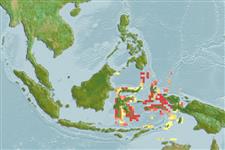>
Ovalentaria/misc (Various families in series Ovalentaria) >
Pomacentridae (Damselfishes) > Pomacentrinae
Etymology: Neoglyphidodon: Greek, para = the side of + Greek, glyphis = carved + Greek, odous = teeth.
Eponymy: Norbert J Cross is an Honorary Associate of the Western Australian Museum (Perth), where Allen works, and with whom he has co-authored papers such as: Description of Five New Rainbowfishes (Melanotaeniidae) From New Guinea (1980) and the book: [...] (Ref. 128868), visit book page.
Environment: milieu / climate zone / depth range / distribution range
Écologie
marin récifal; non migrateur; profondeur 1 - 12 m (Ref. 90102). Tropical; 5°N - 11°S, 119°E - 135°E
Western Central Pacific: known only from Sulawesi and the Moluccas.
Taille / Poids / Âge
Maturity: Lm ? range ? - ? cm
Max length : 10.0 cm SL mâle / non sexé; (Ref. 7247)
Description synthétique
Clés d'identification | Morphologie | Morphométrie
Épines dorsales (Total) : 13; Rayons mous dorsaux (Total) : 14 - 16; Épines anales: 2; Rayons mous anaux: 13 - 14.
Adults inhabit shallow gutters of rocky areas or coral reefs of protected bays and lagoons. Solitary and shy (Ref. 9710). Often swimming near the surface (Ref. 48636). Oviparous, distinct pairing during breeding (Ref. 205). Eggs are demersal and adhere to the substrate (Ref. 205). Males guard and aerate the eggs (Ref. 205). Diurnal species (Ref. 113699).
Life cycle and mating behavior
Maturité | Reproduction | Frai | Œufs | Fécondité | Larves
Oviparous, distinct pairing during breeding (Ref. 205). Eggs are demersal and adhere to the substrate (Ref. 205). Males guard and aerate the eggs (Ref. 205).
Allen, G.R., 1991. Damselfishes of the world. Mergus Publishers, Melle, Germany. 271 p. (Ref. 7247)
Statut dans la liste rouge de l'IUCN (Ref. 130435: Version 2024-1)
Menace pour l'homme
Harmless
Utilisations par l'homme
Outils
Articles particuliers
Télécharger en XML
Sources Internet
Estimates based on models
Preferred temperature (Ref.
123201): 28.4 - 29.2, mean 28.8 °C (based on 140 cells).
Phylogenetic diversity index (Ref.
82804): PD
50 = 0.5020 [Uniqueness, from 0.5 = low to 2.0 = high].
Bayesian length-weight: a=0.02344 (0.01134 - 0.04848), b=2.98 (2.80 - 3.16), in cm total length, based on LWR estimates for this (Sub)family-body shape (Ref.
93245).
Niveau trophique (Ref.
69278): 2.8 ±0.3 se; based on size and trophs of closest relatives
Résilience (Ref.
120179): Haut, temps minimum de doublement de population inférieur à 15 mois (Preliminary K or Fecundity.).
Fishing Vulnerability (Ref.
59153): Low vulnerability (10 of 100).
Nutrients (Ref.
124155): Calcium = 113 [56, 183] mg/100g; Iron = 0.725 [0.421, 1.212] mg/100g; Protein = 18.5 [17.3, 19.6] %; Omega3 = 0.115 [0.067, 0.193] g/100g; Selenium = 18.3 [10.1, 36.3] μg/100g; VitaminA = 113 [33, 367] μg/100g; Zinc = 1.6 [1.1, 2.3] mg/100g (wet weight);
